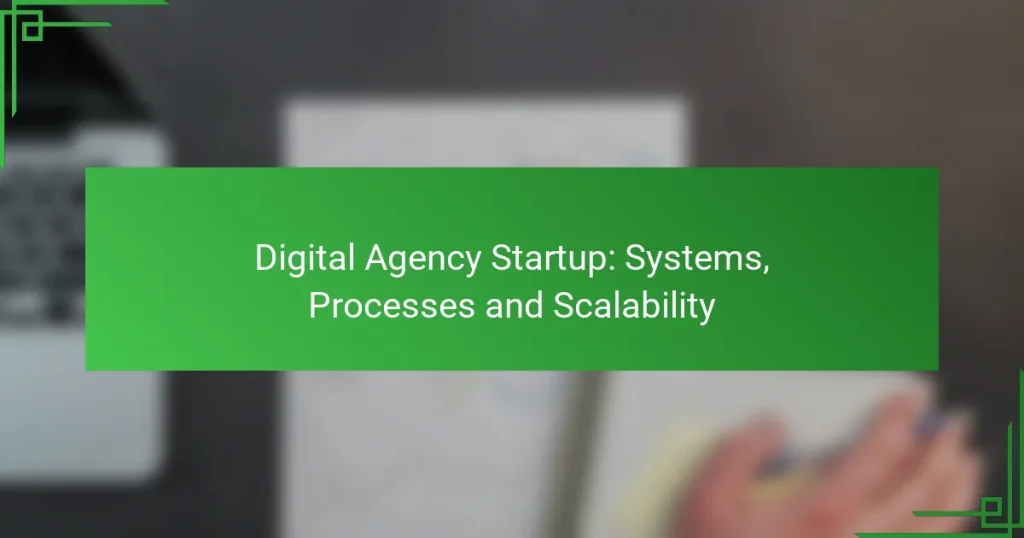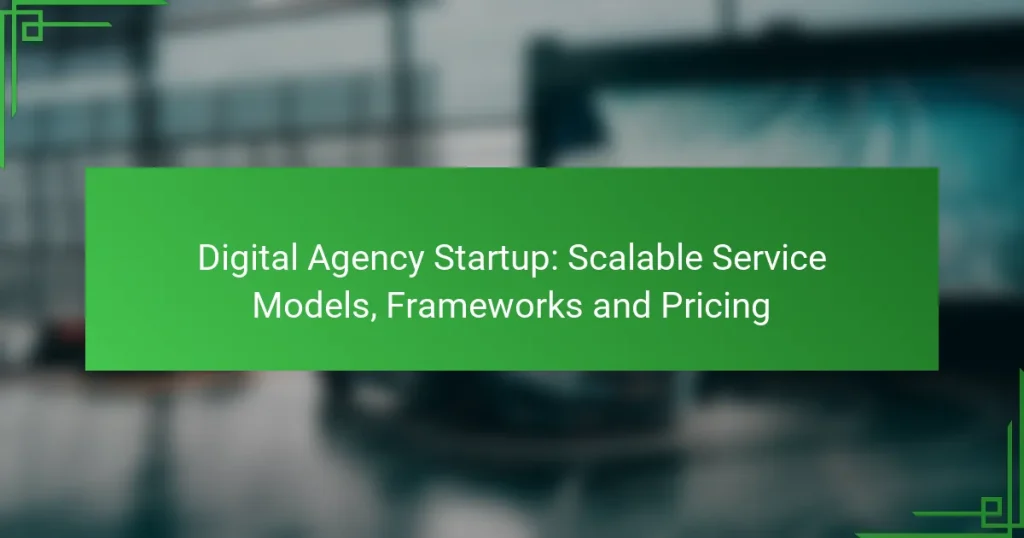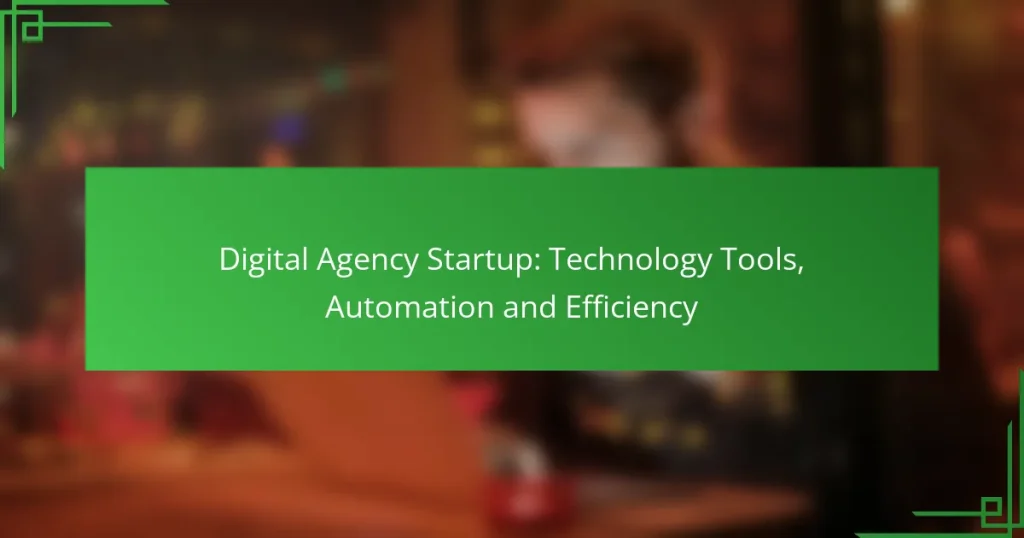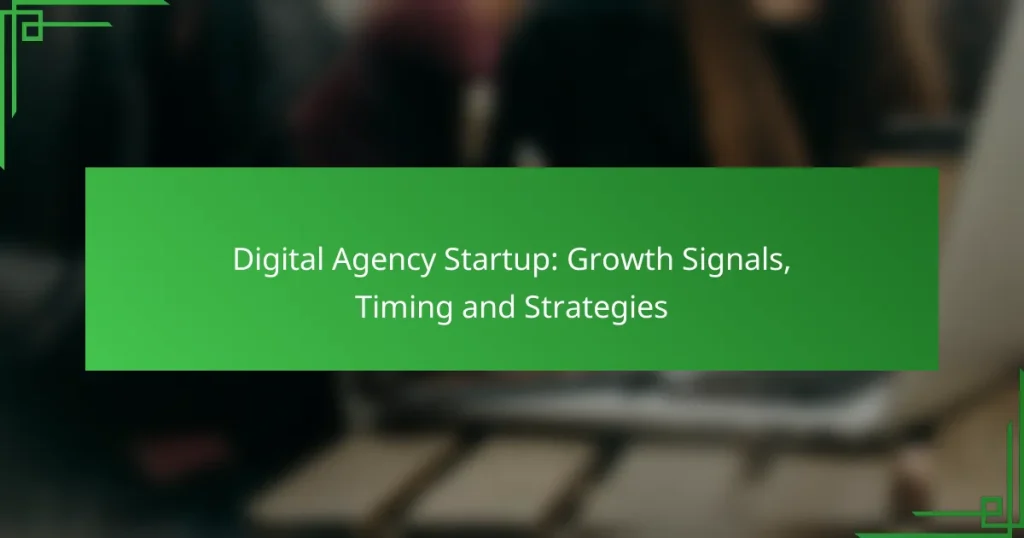Scaling a digital agency requires a strategic approach that emphasizes effective client acquisition, brand visibility, and technology utilization. By optimizing operations and focusing on key performance metrics, agencies can enhance productivity and drive sustainable growth. Understanding and measuring success through client retention, revenue growth, and customer satisfaction is essential for continuous improvement.
Digital Agency Startup: Systems, Processes and Scalability
Digital Agency Startup: Scalable Service Models, Frameworks and Pricing
Digital Agency Startup: Technology Tools, Automation and Efficiency
Digital Agency Startup vs. In-House: Which Is Better and When to Use
Digital Agency Startup: Growth Signals, Timing and Strategies
What Strategies Can Scale a Digital Agency in the US?
To scale a digital agency in the US, focus on effective client acquisition, enhancing brand visibility, and leveraging technology. Implementing these strategies can lead to sustainable growth and increased revenue.
Client acquisition through targeted marketing
Targeted marketing is essential for acquiring clients who align with your agency’s strengths. Utilize data analytics to identify your ideal customer profile and tailor your marketing efforts accordingly. This can include PPC campaigns, SEO strategies, and content marketing that speaks directly to the needs of your target audience.
Consider using platforms like Google Ads and Facebook Ads, which allow for precise demographic targeting. Regularly assess the performance of your campaigns and adjust your strategies based on conversion rates and client feedback.
Leveraging social media for brand visibility
Social media platforms are powerful tools for increasing brand visibility and engaging with potential clients. Create a consistent posting schedule that showcases your agency’s work, shares industry insights, and engages with followers. Platforms like LinkedIn, Instagram, and Twitter can be particularly effective for reaching business clients.
Engagement is key; respond to comments and messages promptly to build relationships. Consider using paid promotions to amplify your reach and target specific demographics relevant to your services.
Building strategic partnerships
Forming strategic partnerships can help expand your agency’s reach and capabilities. Collaborate with complementary businesses, such as web developers or content creators, to offer bundled services that attract more clients. These partnerships can also lead to referrals, creating a mutually beneficial relationship.
When selecting partners, ensure their values and goals align with yours. Establish clear communication and set expectations to maximize the potential of the partnership.
Implementing automation tools
Automation tools can streamline operations and improve efficiency, allowing your agency to focus on growth. Consider using software for project management, customer relationship management (CRM), and marketing automation. Tools like HubSpot or Asana can help manage client interactions and project timelines effectively.
Evaluate your agency’s workflow to identify repetitive tasks that can be automated. This not only saves time but also reduces the likelihood of human error, leading to better client satisfaction.
Offering specialized services
Offering specialized services can differentiate your agency from competitors and attract niche clients. Identify areas where your team excels and develop expertise in those fields, such as SEO for e-commerce or social media marketing for tech startups. This specialization can position your agency as a leader in specific markets.
Market your specialized services through targeted content and case studies that highlight your success in those areas. This approach can help establish credibility and attract clients looking for specific solutions.
How to Optimize Operations for Growth?
To optimize operations for growth, focus on improving efficiency, enhancing collaboration, and leveraging data analytics. Streamlining processes and utilizing the right tools can significantly boost productivity and scalability.
Streamlining project management processes
Streamlining project management involves adopting methodologies that enhance efficiency, such as Agile or Kanban. These frameworks allow for better task prioritization and quicker turnaround times, which are crucial for scaling operations.
Consider using project management software like Trello or Asana to keep track of tasks and deadlines. Establishing clear roles and responsibilities within your team can also minimize confusion and enhance productivity.
Utilizing performance analytics
Utilizing performance analytics helps identify areas for improvement and track progress over time. By analyzing key performance indicators (KPIs) such as project completion rates and client satisfaction scores, you can make informed decisions that drive growth.
Implement tools like Google Analytics or HubSpot to gather data on your agency’s performance. Regularly review this data to adjust strategies and optimize resource allocation effectively.
Enhancing team collaboration
Enhancing team collaboration is essential for a digital agency’s success. Tools like Slack or Microsoft Teams facilitate communication and ensure that team members are aligned on project goals and deadlines.
Encourage regular check-ins and feedback sessions to foster a culture of open communication. This not only improves morale but also leads to better project outcomes as issues are addressed promptly.
What Are the Key Metrics for Measuring Success?
Key metrics for measuring success in a digital agency startup include client retention rates, revenue growth percentage, and customer satisfaction scores. These metrics provide insights into the agency’s performance and help identify areas for improvement.
Client retention rates
Client retention rates indicate the percentage of clients that continue to work with your agency over a specific period. High retention rates suggest strong relationships and satisfaction, while low rates may signal issues that need addressing.
To calculate this metric, divide the number of clients retained during a period by the number of clients at the beginning of that period, then multiply by 100. Aim for retention rates above 70% to ensure a stable client base.
Revenue growth percentage
Revenue growth percentage measures the increase in revenue over a given time frame, typically year-over-year. This metric reflects the agency’s ability to attract new clients and upsell existing ones.
To calculate revenue growth, subtract the previous year’s revenue from the current year’s revenue, divide by the previous year’s revenue, and multiply by 100. A healthy growth rate for digital agencies often ranges from 15% to 30% annually.
Customer satisfaction scores
Customer satisfaction scores assess how satisfied clients are with your agency’s services. These scores can be gathered through surveys or feedback forms and are crucial for understanding client perceptions.
Common methods for measuring satisfaction include Net Promoter Score (NPS) and Customer Satisfaction Score (CSAT). Aim for scores above 80% to indicate a strong level of client satisfaction, which can lead to referrals and repeat business.
What Are the Best Tools for Digital Agencies?
The best tools for digital agencies streamline operations, enhance client relationships, and provide insights into performance. Choosing the right software can significantly impact efficiency and growth.
Asana for project management
Asana is a versatile project management tool that helps teams organize tasks, set deadlines, and track progress. It allows for collaboration through shared projects and task assignments, ensuring everyone stays on the same page.
Consider using Asana’s templates for common workflows to save time. The platform supports integrations with other tools, such as Slack and Google Drive, which can enhance productivity. Regularly review project timelines to adjust workloads and avoid bottlenecks.
HubSpot for CRM
HubSpot is a comprehensive customer relationship management (CRM) platform that helps agencies manage client interactions and data. It offers features for tracking leads, nurturing relationships, and automating marketing tasks.
Utilize HubSpot’s reporting tools to analyze sales performance and customer engagement. The free tier is a good starting point for small agencies, while larger firms may benefit from the paid plans that offer advanced features. Regularly update your contact database to maintain accurate records.
Google Analytics for performance tracking
Google Analytics is an essential tool for tracking website performance and user behavior. It provides insights into traffic sources, user demographics, and conversion rates, helping agencies make data-driven decisions.
Set up goals and conversion tracking to measure the effectiveness of marketing campaigns. Regularly review key metrics, such as bounce rates and average session duration, to identify areas for improvement. Familiarize yourself with the platform’s reporting features to maximize its potential for your agency.
How to Build a Strong Brand Identity?
Building a strong brand identity involves creating a unique image and personality that resonates with your target audience. This identity should reflect your values, mission, and the overall experience you want to deliver to your customers.
Defining brand values and mission
Defining your brand values and mission is crucial for establishing a strong identity. Start by identifying what principles guide your business and what you aim to achieve. These values should align with your target audience’s beliefs and needs.
For example, if your agency prioritizes sustainability, make this a core value that informs your decisions and marketing. This alignment can foster loyalty and trust among clients who share similar values.
Creating a cohesive visual identity
A cohesive visual identity includes your logo, color palette, typography, and overall design style. These elements should work together to create a recognizable and memorable brand image. Consistency across all platforms, from your website to social media, reinforces your identity.
Consider using a style guide to maintain uniformity in visual elements. This guide should outline specifications for logo usage, color codes, and font styles to ensure that your brand looks the same everywhere it appears.
Engaging storytelling in marketing
Engaging storytelling is a powerful tool for building a brand identity. Use narratives that connect emotionally with your audience, showcasing your brand values and mission through real-life examples or customer testimonials.
For instance, share stories about how your agency has helped clients overcome challenges or achieve their goals. This not only humanizes your brand but also demonstrates the impact of your services, making your identity more relatable and memorable.





